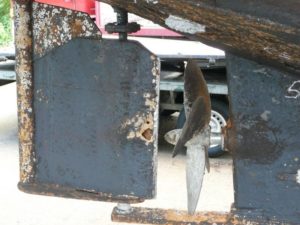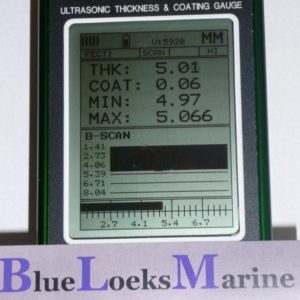Ultrasonic thickness measurement on a yacht or boat.
How is the hull inspected for her condition.
First the yacht is, as much as accessible, visual inspected from the inside of the hull. Often rust formation is present, which is not noticeable on the outside.

During the internal inspection of the hull we also the can check the presence of ‘suspect’ locations and items such as shower, toilet, standpipes, through hull fittings etc.
After careful and methodical hammering of the outer the hull below the water line ultrasonic thickness measurements are taken in a representative number of points per side. The “suspicious” spots are extra measure if necessary. For such ‘normal’ extra measurements no additional fee will be charged.
We also check the depth, appearance and spread of pitting at representative locations.
Thick, soft layers of coating, as anti-fouling sometimes affects the signals of the thickness measurement device. In that case such layer will be removed locally, such that the primary coating system remains intact. Grinding is usual not necessary with modern coating systems.
Hull condition survey, Ultrasonic thickness measurements, what we do and why.

We also inspect the rudder, the anodes, propeller etc. All components which usual are underwater.
The entire underwater hull and the components on it are scrutinized for defects or condition.
We strongly advise to carry out a hull survey, thickness measurements, on your boat or yacht, even if your insurance does not require such at time of purchase or periodical every 3- 5 years.
With a hull survey you have a written proof of the condition of your hull, as ascertained by an independent yacht surveyor. You can not be blamed for negligence by have such survey performed and if you have followed the recommendations made.
At time of the hull-survey, ultra thickness measurement, the ships bottom and sides should be good accessible on shore and be cleaned from debris, barnacles etc. The surface should be dry.
Visual inspection of the underwater hull and ultrasonic thickness measurement are part of the full pre-purchase inspection, survey. It can also be carried out as partial survey, so without the full pre-purchase survey of a yacht or boat..
Ultrasonic Thickness Measurements, with minor damage to coating
Blue Marine Loeks uses ultrasonic thickness meters which can measure the paint thickness and the material thickness through a coating. . Grinding or scraping is often not necessary with modern intact coatings, provide the surface is flat. When scraping is necessary, first only the top layer, anti-fouling,is removed in order to obtain reliable readings.

The yacht usually does not have to remain ashore for touching up the coating system. If incidentally the coating has to be removed, we advise to keep a left over of the used paint system at hand during the inspection for touching up the spots . By such immediate action you avoid additional cost for storage.
The ultrasonic thickness measurements are taken from one side of the material. The so-called B-Scan gives an indication of the condition of the material on the back side, presence of corrosion and the steel or aluminum thickness. The measurements are clearly noted in our report and also written on the hull during the inspection with chalk.
Thickness Measurement of other objects

Regularly we also perform ultrasonic thickness measurements on so-called shore-based objects. This relates to objects, no marine related, which are difficult or not removable from their location, and of which the client wishes to have an indication of the thickness of steel. In fact all solid materials can be ultrasonic measured on thickness by our equipment. It does not have to be related to yachts or boats
In fact with our equipment we can measure the thickness of any hard, solid material, not only metals.
For example, thickness measurements of pipes, filters and pumps of public swimming pools or sewage pump installations.



